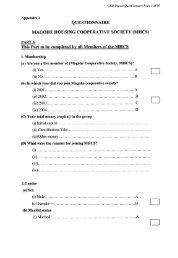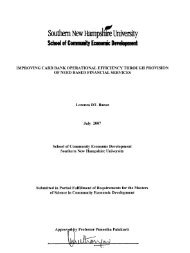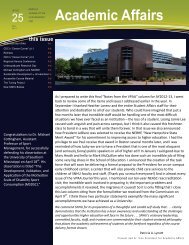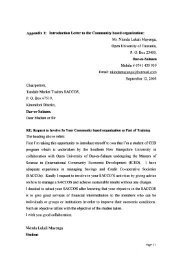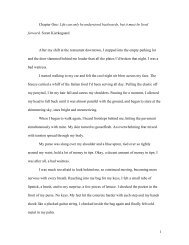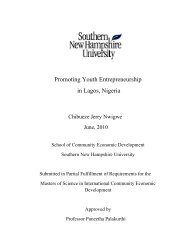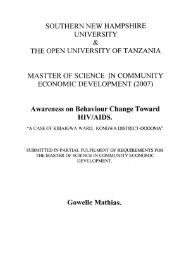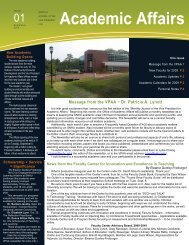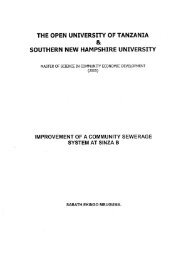SNHU Academic Archive - Southern New Hampshire University
SNHU Academic Archive - Southern New Hampshire University
SNHU Academic Archive - Southern New Hampshire University
Create successful ePaper yourself
Turn your PDF publications into a flip-book with our unique Google optimized e-Paper software.
<strong>SNHU</strong> <strong>Academic</strong> <strong>Archive</strong><br />
Guide to using Dublin Core Qualified in the <strong>SNHU</strong> <strong>Academic</strong> <strong>Archive</strong><br />
Last modification date: March 10, 2010<br />
Note for all fields: Do not add punctuation to the end of the information entered into a field,<br />
unless it is already present in the resource. For example, the end of an abstract would end<br />
with some form of punctuation; the title, however, generally does not.<br />
Dublin Core Element<br />
Dublin Core Qualifier<br />
Definition<br />
Rationale<br />
contributor<br />
author<br />
An entity primarily responsible for making the resource.<br />
The name of the creator is often used to identify the resource. A user<br />
will often request or search for a resource by the creator.<br />
Data constraint<br />
Last, First Middle<br />
Examples Fox, Michael J.<br />
<strong>Southern</strong> <strong>New</strong> <strong>Hampshire</strong> <strong>University</strong><br />
Repeatability<br />
Repeatable<br />
Obligation<br />
Not mandatory<br />
Creation/ Maintenance notes Use the unqualified contributor element when the type of contribution<br />
is unknown or unspecified (such as an illustrator). If new collections<br />
are added to the repository where a new type of contributor is<br />
common, a new qualifier should be added to DSpace.<br />
Usage notes<br />
In DSpace, enter the Middle name after the First name in the First<br />
name field. If the name is a corporate entity (such as <strong>Southern</strong> <strong>New</strong><br />
<strong>Hampshire</strong> <strong>University</strong>) enter the name in its entirety in the Last name<br />
field.
Guide to using Dublin Core Qualified in the <strong>SNHU</strong> <strong>Academic</strong> <strong>Archive</strong> 2<br />
Dublin Core Element<br />
Dublin Core Qualifier<br />
Definition<br />
Rationale<br />
contributor<br />
editor<br />
An entity responsible for editing the resource.<br />
The name of the editor may be used to identify the resource. A user<br />
will often request or search for a resource by the editor.<br />
Data constraint<br />
Last, First Middle<br />
Examples Fox, Michael J.<br />
<strong>Southern</strong> <strong>New</strong> <strong>Hampshire</strong> <strong>University</strong><br />
Repeatability<br />
Repeatable<br />
Obligation<br />
Not mandatory<br />
Creation/ Maintenance notes Use the unqualified contributor element when the type of contribution<br />
is unknown or unspecified (such as an illustrator). If new collections<br />
are added to the repository where a new type of contributor is<br />
common, a new qualifier should be added to DSpace.<br />
Usage notes<br />
In DSpace, enter the Middle name after the First name in the First<br />
name field. If the name is a corporate entity (such as <strong>Southern</strong> <strong>New</strong><br />
<strong>Hampshire</strong> <strong>University</strong>) enter the name in its entirety in the Last name<br />
field.
Guide to using Dublin Core Qualified in the <strong>SNHU</strong> <strong>Academic</strong> <strong>Archive</strong> 3<br />
Dublin Core Element<br />
Dublin Core Qualifier<br />
Definition<br />
Rationale<br />
contributor<br />
n/a<br />
An entity responsible for making contributions to the resource (who is<br />
not the creator or editor).<br />
Names of creators may be used to identify the resource. A user will<br />
often request or search for a resource by a creator.<br />
Data constraint<br />
Last, First Middle<br />
Examples Fox, Michael J.<br />
<strong>Southern</strong> <strong>New</strong> <strong>Hampshire</strong> <strong>University</strong><br />
Repeatability<br />
Repeatable<br />
Obligation<br />
Not mandatory<br />
Creation/ Maintenance notes Use the unqualified contributor element when the type of contribution<br />
is unknown or unspecified (such as an illustrator). If new collections<br />
are added to the repository where a new type of contributor is<br />
common, a new qualifier should be added to DSpace.<br />
Usage notes<br />
In DSpace, enter the Middle name after the First name in the First<br />
name field. If the name is a corporate entity, enter the name in its<br />
entirety in the Last name field.
Guide to using Dublin Core Qualified in the <strong>SNHU</strong> <strong>Academic</strong> <strong>Archive</strong> 4<br />
Dublin Core Element<br />
Dublin Core Qualifiers<br />
Definition<br />
Rationale<br />
Data constraint<br />
Examples<br />
Repeatability<br />
Obligation<br />
Creation/ Maintenance notes<br />
title<br />
n/a<br />
A name given to the resource.<br />
The name given to the resource is often used to identify the resource.<br />
A user will often request or search for a resource by the title.<br />
Capitalize the first word (of a title, for example) and proper names<br />
(place, personal, and organization names). Acronyms should be<br />
entered in capital letters.<br />
Project in Community Economic Development final report : <strong>New</strong><br />
Bedford Working Capital Network progress panel<br />
***<br />
Canvassing indigenous economics : The Oneida Trust Fund as a<br />
socially responsible investment model from passive rhetoric to<br />
proactive reality<br />
Not repeatable<br />
Mandatory<br />
Currently, there isn’t a Dublin Core qualifier for subtitles.<br />
Usage notes<br />
To be referenced directly from the title page of the document,<br />
including any misspellings.<br />
***<br />
Subtitles should be included after a colon; see example.
Guide to using Dublin Core Qualified in the <strong>SNHU</strong> <strong>Academic</strong> <strong>Archive</strong> 5<br />
Dublin Core Element<br />
Dublin Core Qualifier<br />
Definition<br />
Rationale<br />
Data constraint<br />
Examples<br />
Repeatability<br />
Obligation<br />
Creation/ Maintenance notes<br />
title<br />
alternative<br />
A name given to the resource.<br />
The name given to the resource is often used to identify the resource.<br />
A user will often request or search for a resource by the title.<br />
Capitalize the first word (of a title, for example) and proper names<br />
(place, personal, and organization names). Acronyms should be<br />
entered in capital letters.<br />
Project in Community Economic Development final report : <strong>New</strong><br />
Bedford Working Capital Network progress panel<br />
***<br />
Canvassing indigenous economics : The Oneida Trust Fund as a<br />
socially responsible investment model from passive rhetoric to<br />
proactive reality<br />
Repeatable<br />
Not mandatory<br />
Currently, there isn’t a Dublin Core qualifier for subtitles.<br />
Usage notes<br />
To be used for any other possible spellings of the title, such as<br />
correcting misspellings or providing alternative spellings (such as 100<br />
vs. one hundred).<br />
***<br />
Subtitles should be included after a colon; see example.
Guide to using Dublin Core Qualified in the <strong>SNHU</strong> <strong>Academic</strong> <strong>Archive</strong> 6<br />
Dublin Core Element<br />
Dublin Core Qualifier<br />
Definition<br />
Rationale<br />
date<br />
issued<br />
The date of the issuance of the resource.<br />
The issued date is often used to help identify the resource or describes<br />
the age of the resource.<br />
Data constraint<br />
The year is mandatory, in YYYY format.<br />
Examples 1983<br />
Repeatability<br />
Not repeatable<br />
Obligation<br />
Mandatory<br />
Creation/ Maintenance notes Look in the future for the capability to enter special characters in the<br />
date field; see usage note below.<br />
Usage notes<br />
DSpace does not allow characters used for “guesses” – such as 198- or<br />
[1983]. A date is uncertain when it is not printed on the resource.<br />
If a date is uncertain, enter the best guess.<br />
For CED projects, for consistency just enter the year for all projects.
Guide to using Dublin Core Qualified in the <strong>SNHU</strong> <strong>Academic</strong> <strong>Archive</strong> 7<br />
Dublin Core Element<br />
Dublin Core Qualifier<br />
Definition<br />
Rationale<br />
date<br />
copyright<br />
The date of the copyright of the resource.<br />
The copyright date is often used to help identify the resource or<br />
describes the age of the resource.<br />
Data constraint<br />
The year is mandatory, in YYYY format. Month and/or day can be<br />
entered if available.<br />
Examples 1983<br />
Repeatability<br />
Not repeatable<br />
Obligation<br />
Not mandatory<br />
Creation/ Maintenance notes<br />
Usage notes<br />
date.copyright should only be used if it is different from the<br />
date.issued.
Guide to using Dublin Core Qualified in the <strong>SNHU</strong> <strong>Academic</strong> <strong>Archive</strong> 8<br />
Dublin Core Element<br />
Dublin Core Qualifier<br />
Definition<br />
Rationale<br />
type<br />
n/a<br />
The nature or genre of the resource.<br />
Knowing the type helps users quickly identify the resource.<br />
Data constraint<br />
Examples<br />
Repeatability<br />
Obligation<br />
Creation/ Maintenance notes<br />
Must be a selection from the following terms, predefined in DSpace:<br />
Abstract or Summary<br />
Article<br />
Book<br />
Book chapter<br />
Catalog<br />
Conference paper<br />
Dataset<br />
Dissertation<br />
Essay<br />
Fiction<br />
Honors Project<br />
Journal<br />
Map<br />
Memoir<br />
<strong>New</strong>spaper<br />
Non-fiction<br />
Other<br />
Periodical<br />
Presentation<br />
Poetry<br />
Short Story<br />
Sound<br />
Speech<br />
Statistics<br />
Technical Report<br />
Thesis<br />
Video<br />
Web site<br />
Working Paper<br />
Repeatable<br />
Not mandatory<br />
If “other” is used often, an examination should be made to see if a new<br />
term is necessary. A new term must be programmed into the system.<br />
The terms above are consistent with the MARC Value List for Genre<br />
Terms, with the addition of the term “dissertation”.
Guide to using Dublin Core Qualified in the <strong>SNHU</strong> <strong>Academic</strong> <strong>Archive</strong> 9<br />
Usage notes<br />
Avoid using “other” when possible.<br />
Records that do not have bitstreams (attached files, such as PDFs)<br />
should be classified as “Abstract or Summary”.
Guide to using Dublin Core Qualified in the <strong>SNHU</strong> <strong>Academic</strong> <strong>Archive</strong> 10<br />
Dublin Core Element<br />
Dublin Core Qualifier<br />
Definition<br />
Rationale<br />
Data constraint<br />
Examples<br />
Repeatability<br />
Obligation<br />
Creation/ Maintenance notes<br />
Usage notes<br />
description<br />
abstract<br />
A summary of the resource.<br />
Abstracts are helpful for the user to quickly identify the contents and<br />
subject matter of the resource.<br />
The Bates Street Senior Housing development, a project of<br />
Community Concepts, Inc, in Lewiston, Maine, incorporates Low<br />
Income Tax Credits, Federal HOME funds and a grant from<br />
MaineHousing. This creates a model of senior housing that also falls<br />
under the umbrella of affordable rental housing. (Library-derived<br />
description)<br />
Not repeatable<br />
Not mandatory<br />
The display label in DSpace is “abstract/description”.<br />
Recommended for use with student projects, theses, dissertations. Use<br />
abstracts provided by the students when possible/practical.<br />
Student-provided abstracts should close with (Author abstract)<br />
Descriptions written by another party/cataloger should close with<br />
(Library-derived description)<br />
Format tips for descriptions/abstracts<br />
When abstracts are copied and pasted from a PDF, special care should be taken to ensure that any<br />
hard returns that erroneously occur at the end of each line are removed. This is probably best<br />
accomplished by pasting the abstract into WordPad, which has a window that can easily be resized so<br />
you can see where the breaks are.<br />
Paragraph breaks should be divided by a blank line, as shown in this example.<br />
Special care should also be taken when handling bullets:<br />
- The end of each bullet point does get a hard return at the end of each line.<br />
- Most bullets will probably not copy/paste as the bullet symbol. Use a hyphen and a space instead as<br />
indicated by this example.<br />
- This is also true for numbered lists and tables of contents, although of course the hyphens would be<br />
replaced by whatever character is appropriate, if any.<br />
When formatting is complete, copy and paste text from WordPad. Don’t forget to close the abstract<br />
with: (Author abstract) or (Library-derived description)
Guide to using Dublin Core Qualified in the <strong>SNHU</strong> <strong>Academic</strong> <strong>Archive</strong> 11<br />
Dublin Core Element<br />
Dublin Core Qualifier<br />
Definition<br />
Rationale<br />
Data constraint<br />
Examples<br />
Repeatability<br />
Obligation<br />
Creation/ Maintenance notes<br />
description<br />
n/a<br />
A short description of the resource.<br />
For use with documents such as images or data sets that do not<br />
traditionally have abstracts. This element provides an area for a short<br />
textual description of the resource.<br />
Librarians all dressed up for Halloween<br />
Repeatable<br />
Not mandatory<br />
Usage notes
Guide to using Dublin Core Qualified in the <strong>SNHU</strong> <strong>Academic</strong> <strong>Archive</strong> 12<br />
Dublin Core Element<br />
Dublin Core Qualifier<br />
Definition<br />
Rationale<br />
Data constraint<br />
Examples<br />
Repeatability<br />
Obligation<br />
Creation/ Maintenance notes<br />
description<br />
tableofcontents<br />
The table of contents of the resource.<br />
The table of contents provides descriptive information about the<br />
resource.<br />
Capitalize the first word (of a title, for example) and proper names<br />
(place, personal, and organization names). Acronyms should be<br />
entered in capital letters. They should only be numbered as they are<br />
numbered in the original document. Page numbers should be removed.<br />
The beginning<br />
The middle of Pippi Longstocking<br />
Ending of the book<br />
Not repeatable<br />
Not mandatory<br />
Usage notes
Guide to using Dublin Core Qualified in the <strong>SNHU</strong> <strong>Academic</strong> <strong>Archive</strong> 13<br />
Dublin Core Element<br />
Dublin Core Qualifier<br />
Definition<br />
Rationale<br />
Data constraint<br />
Examples<br />
Repeatability<br />
Obligation<br />
Creation/ Maintenance notes<br />
description<br />
degree<br />
Indicates the degree received in association with the resource.<br />
Theses and dissertations are required to receive a degree; knowing<br />
what type of degree was received helps to describe the nature of the<br />
resource.<br />
Must be selected from a predetermined list of terms in DSpace:<br />
Master of Arts (M.A.)<br />
Master of Business Administration (M.B.A.)<br />
Master of Education (M.Ed.)<br />
Master of Fine Arts (M.F.A.)<br />
Master of Science (M.S.)<br />
Doctor of Business Administration (D.B.A.)<br />
Doctor of Philosophy (Ph.D.)<br />
Master of Arts (M.A.)<br />
Not repeatable<br />
Not mandatory<br />
If new degrees are added at <strong>SNHU</strong>, they will need to be programmed<br />
for use.<br />
Usage notes
Guide to using Dublin Core Qualified in the <strong>SNHU</strong> <strong>Academic</strong> <strong>Archive</strong> 14<br />
Dublin Core Element<br />
Dublin Core Qualifier<br />
Definition<br />
Rationale<br />
Data constraint<br />
Examples<br />
Repeatability<br />
Obligation<br />
Creation/ Maintenance notes<br />
description<br />
school<br />
The school that issued the degree associated with the resource.<br />
Theses and dissertations are required to receive a degree; knowing<br />
which school granted the degree helps to describe the nature of the<br />
resource.<br />
School of Business<br />
or<br />
School of Liberal Arts<br />
Not repeatable<br />
Not mandatory<br />
Usage notes<br />
Schools should not be retroactively changed – they should be entered<br />
using the name that existed when the resource was created.
Guide to using Dublin Core Qualified in the <strong>SNHU</strong> <strong>Academic</strong> <strong>Archive</strong> 15<br />
Dublin Core Element<br />
Dublin Core Qualifier<br />
Definition<br />
Rationale<br />
Data constraint<br />
Examples<br />
Repeatability<br />
Obligation<br />
Creation/ Maintenance notes<br />
description<br />
program<br />
The program or department that issued the degree associated with the<br />
resource.<br />
Theses and dissertations are required to receive a degree; knowing<br />
which program or department granted the degree helps to describe the<br />
nature of the resource.<br />
These are proper names, so the first letters should be capitalized.<br />
Communication<br />
or<br />
Graphic Design<br />
or<br />
Finance<br />
Not repeatable<br />
Not mandatory<br />
Usage notes
Guide to using Dublin Core Qualified in the <strong>SNHU</strong> <strong>Academic</strong> <strong>Archive</strong> 16<br />
Dublin Core Element<br />
Dublin Core Qualifier<br />
Definition<br />
Rationale<br />
contributor<br />
advisor<br />
The faculty advisor who accepted a student’s<br />
thesis/dissertation/student project.<br />
A student or researcher may find it helpful to browse projects<br />
associated with a particular member of faculty.<br />
Data constraint<br />
Last, First Middle<br />
Examples Jacobs, Eric L.<br />
Repeatability<br />
Repeatable<br />
Obligation<br />
Not mandatory<br />
Creation/ Maintenance notes<br />
Usage notes<br />
In DSpace, enter the Middle name after the First name in the First<br />
name field.
Guide to using Dublin Core Qualified in the <strong>SNHU</strong> <strong>Academic</strong> <strong>Archive</strong> 17<br />
Dublin Core Element<br />
Dublin Core Qualifier<br />
Definition<br />
Rationale<br />
contributor<br />
committeemember<br />
The name of a faculty member on the committee to approve a<br />
student’s dissertation.<br />
A student or researcher may find it helpful to browse projects<br />
associated with a particular member of faculty.<br />
Data constraint<br />
Last, First Middle<br />
Examples Rivera, Jolan C.<br />
Repeatability<br />
Repeatable<br />
Obligation<br />
Not mandatory<br />
Creation/ Maintenance notes<br />
Usage notes<br />
In DSpace, enter the Middle name after the First name in the First<br />
name field.
Guide to using Dublin Core Qualified in the <strong>SNHU</strong> <strong>Academic</strong> <strong>Archive</strong> 18<br />
Dublin Core Element<br />
Dublin Core Qualifier<br />
Definition<br />
Rationale<br />
Data constraint<br />
Examples<br />
Repeatability<br />
Obligation<br />
Creation/ Maintenance notes<br />
language<br />
n/a<br />
The language(s) used in the resource.<br />
It is very helpful to indicate the language used when resources are<br />
distributed on a global scale.<br />
Choices of languages are predefined by DSpace. The ISO abbreviation<br />
is automatically entered by DSpace.<br />
Select “English (United States)”. The resulting metadata will display:<br />
“en_US”<br />
Repeatable<br />
Not mandatory<br />
Usage notes<br />
For multilingual resources, indicate all languages (use Ctrl key).<br />
CED Projects from the Open <strong>University</strong> of Tanzania should be<br />
categorized as “English” and not “English (United States)”.
Guide to using Dublin Core Qualified in the <strong>SNHU</strong> <strong>Academic</strong> <strong>Archive</strong> 19<br />
Dublin Core Element<br />
Dublin Core Qualifier<br />
Definition<br />
Rationale<br />
Data constraint<br />
Examples<br />
Repeatability<br />
Obligation<br />
Creation/ Maintenance notes<br />
subject<br />
other<br />
A term or short phrase representing the primary topic(s) on which a<br />
work is focused.<br />
Subject keywords help facilitate the search process, and ensure that<br />
various resources with the same subjects may be cross-referenced.<br />
Terms may be selected from a controlled list.<br />
Tanzania<br />
Vermont<br />
Housing<br />
Agriculture<br />
Poultry<br />
Repeatable<br />
Not mandatory<br />
Usage notes<br />
If applicable, enter the geographic location of the topic of the resource.<br />
See guidelines on following page.
Guide to using Dublin Core Qualified in the <strong>SNHU</strong> <strong>Academic</strong> <strong>Archive</strong> 20<br />
Standards for entering geographic metadata into records for CED student thesis projects and<br />
dissertations<br />
Background<br />
DSpace does not support hierarchical subject browsing, therefore, multi-term formats such as Library<br />
of Congress Subject Headings are not appropriate.<br />
Therefore, the geographic subject terms will be entered alongside other subject keywords, using the<br />
subject.other element.<br />
Guidelines<br />
For each project, geographic terms should include:<br />
Town name, with state abbreviated in parentheses<br />
Example: Manchester (NH)<br />
State name, spelled out, with country abbreviation in parentheses<br />
Example: <strong>New</strong> <strong>Hampshire</strong> (US)<br />
If outside the United States:<br />
Town name, with country abbreviated in parentheses<br />
Example: Arusha (TZ)<br />
Country name, spelled out<br />
Example: Tanzania<br />
Resources<br />
2-letter abbreviations for countries:<br />
http://www.iso.org/iso/country_codes/iso_3166_code_lists/english_country_names_and_code_element<br />
s.htm<br />
You can use this shorter URL for easier copying and pasting:<br />
http://tinyurl.com/2d22r3<br />
2-letter abbreviations for states in the U.S.:<br />
http://www.usps.com/ncsc/lookups/usps_abbreviations.html
Guide to using Dublin Core Qualified in the <strong>SNHU</strong> <strong>Academic</strong> <strong>Archive</strong> 21<br />
Dublin Core Element<br />
Dublin Core Qualifier<br />
Definition<br />
Rationale<br />
Data constraint<br />
Examples<br />
Repeatability<br />
Obligation<br />
Creation/ Maintenance notes<br />
subject<br />
lcsh<br />
A term or short phrase representing the primary topic(s) on which a<br />
work is focused.<br />
Subject keywords help facilitate the search process, and ensure that<br />
various resources with the same subjects may be cross-referenced.<br />
Terms should be selected from the Library of Congress Subject<br />
Headings.<br />
Repeatable<br />
Not mandatory<br />
Usage notes
Guide to using Dublin Core Qualified in the <strong>SNHU</strong> <strong>Academic</strong> <strong>Archive</strong> 22<br />
Dublin Core Element<br />
Dublin Core Qualifier<br />
Definition<br />
Rationale<br />
Data constraint<br />
Examples<br />
Repeatability<br />
Obligation<br />
Creation/ Maintenance notes<br />
publisher<br />
n/a<br />
An entity responsible for making the resource available. Often, but<br />
not always, the publisher owns the rights to distribute/reproduce the<br />
work.<br />
It is useful for users and administrators to be aware of who manages<br />
the distribution of the resource.<br />
Usually a corporate name. Use the corporate name as defined by the<br />
Library of Congress Authorities if possible.<br />
Simon & Schuster<br />
<strong>New</strong> York Times Company<br />
Repeatable<br />
Not mandatory<br />
Usage notes<br />
<strong>Academic</strong> work such as theses and dissertations are considered<br />
published by the university when they are made available in a<br />
repository.
Guide to using Dublin Core Qualified in the <strong>SNHU</strong> <strong>Academic</strong> <strong>Archive</strong> 23<br />
Dublin Core Element<br />
Dublin Core Qualifier<br />
Definition<br />
Rationale<br />
rightsHolder<br />
n/a<br />
A person or organization owning or managing rights over the resource.<br />
It is useful for users and administrators to be aware of who owns the<br />
rights to a resource.<br />
Data constraint<br />
Last, First Middle or Organization Name<br />
Examples Reese, David T.<br />
<strong>Southern</strong> <strong>New</strong> <strong>Hampshire</strong> <strong>University</strong><br />
Repeatability<br />
Not repeatable<br />
Obligation<br />
Not mandatory<br />
Creation/ Maintenance notes Created because the CED collection is licensed for use by <strong>SNHU</strong>, but<br />
the rights are owned by the creators.<br />
Usage notes<br />
If there is a Publisher, and the Publisher retains the rights,<br />
rightsHolder is unnecessary. However, if there is a publisher, but the<br />
author (or another entity) still retains the rights to the work, this field<br />
must be used.
Guide to using Dublin Core Qualified in the <strong>SNHU</strong> <strong>Academic</strong> <strong>Archive</strong> 24<br />
Dublin Core Element<br />
Dublin Core Qualifier<br />
Definition<br />
Rationale<br />
Data constraint<br />
Examples<br />
Repeatability<br />
Obligation<br />
Creation/ Maintenance notes<br />
rights<br />
n/a<br />
Information about rights held in and over the resource. Typically,<br />
rights information includes a statement about various property rights<br />
associated with the resource, including intellectual property rights.<br />
While the license agreement is included with all the resources in<br />
DSpace, it would not be collected by metadata harvesters.<br />
No formal constraints; see example for preferred format.<br />
Author retains all ownership rights. Further reproduction in violation<br />
of copyright is prohibited.<br />
Not repeatable<br />
Not mandatory<br />
Created because the CED collection is licensed for use by <strong>SNHU</strong>, but<br />
the rights are owned by the creators.<br />
Usage notes<br />
Use example above for all student and faculty works that are licensed<br />
to <strong>SNHU</strong> for distribution.
Guide to using Dublin Core Qualified in the <strong>SNHU</strong> <strong>Academic</strong> <strong>Archive</strong> 25<br />
Dublin Core Element<br />
Dublin Core Qualifier<br />
Definition<br />
Rationale<br />
description<br />
bibliographicCitation<br />
A bibliographic reference for the resource.<br />
To provide a citation for students and researchers’ use.<br />
Data constraint<br />
Use the citation style preferred by the discipline.<br />
Examples<br />
Casey, N. (1987). Green Island/Vernon Hill Community Development<br />
Corporation, Inc. Retrieved from http://academicarchive.snhu.edu<br />
Repeatability<br />
Repeatable<br />
Obligation<br />
Not mandatory<br />
Creation/ Maintenance notes Example is according to the 6 th edition of the APA Style Manual –<br />
Dissertation/Thesis from a Database.<br />
Usage notes<br />
The Community Economic Development program uses APA Style.
Guide to using Dublin Core Qualified in the <strong>SNHU</strong> <strong>Academic</strong> <strong>Archive</strong> 26<br />
Dublin Core Element<br />
Dublin Core Qualifier<br />
Definition<br />
Rationale<br />
source<br />
n/a<br />
A related resource from which the described resource is derived.<br />
Important for both researchers and for provenance.<br />
Data constraint<br />
Examples<br />
Repeatability<br />
Obligation<br />
Creation/ Maintenance notes<br />
No formal constraints; see example for preferred format.<br />
Bound CED Project Report, Shapiro Library, <strong>Southern</strong> <strong>New</strong><br />
<strong>Hampshire</strong> <strong>University</strong>.<br />
Not repeatable<br />
Not mandatory<br />
Usage notes<br />
Be consistent!
Guide to using Dublin Core Qualified in the <strong>SNHU</strong> <strong>Academic</strong> <strong>Archive</strong> 27<br />
Dublin Core Element<br />
Dublin Core Qualifier<br />
Definition<br />
Rationale<br />
identifier<br />
uri<br />
An unambiguous reference to the resource within a given context.<br />
An identifier is necessary to uniquely identify each resource.<br />
Data constraint<br />
Examples<br />
Repeatability<br />
Obligation<br />
Creation/ Maintenance notes<br />
Data is automatically created by DSpace and the Handle System.<br />
http://hdl.handle.net/10474/18<br />
Not repeatable<br />
Mandatory<br />
The Handle System was implemented to automatically create<br />
identifiers unique to each resource. 10474 is the prefix for <strong>SNHU</strong>.<br />
Usage notes
Guide to using Dublin Core Qualified in the <strong>SNHU</strong> <strong>Academic</strong> <strong>Archive</strong> 28<br />
Dublin Core Element<br />
Dublin Core Qualifier<br />
Definition<br />
Rationale<br />
relation<br />
hasPart<br />
A related resource that is included either physically or logically in the<br />
described resource.<br />
To define relationships between resources.<br />
Data constraint<br />
Examples<br />
Repeatability<br />
Obligation<br />
Creation/ Maintenance notes<br />
Use the URI of the related resource.<br />
http://hdl.handle.net/10474/18<br />
Repeatable<br />
Not mandatory<br />
Usage notes<br />
If this resource is, for example, a journal, that has other multiple parts<br />
that stand alone in the repository – for example, an article.
Guide to using Dublin Core Qualified in the <strong>SNHU</strong> <strong>Academic</strong> <strong>Archive</strong> 29<br />
Dublin Core Element<br />
Dublin Core Qualifier<br />
Definition<br />
Rationale<br />
Data constraint<br />
Examples<br />
Repeatability<br />
Obligation<br />
Creation/ Maintenance notes<br />
relation<br />
hasVersion<br />
A related resource that is a version, edition, or adaptation of the<br />
described resource.<br />
Written resources often have related versions; earlier drafts, editions,<br />
etc. This element defines those relationships in the repository.<br />
Use the URI of the related resource.<br />
http://hdl.handle.net/10474/18<br />
Repeatable<br />
Not mandatory<br />
Usage notes<br />
Use when the resource has another version in the repository, such as a<br />
rough draft or earlier edition.
Guide to using Dublin Core Qualified in the <strong>SNHU</strong> <strong>Academic</strong> <strong>Archive</strong> 30<br />
Dublin Core Element<br />
Dublin Core Qualifier<br />
Definition<br />
Rationale<br />
relation<br />
isPartOf<br />
A related resource in which the described resource is physically or<br />
logically included.<br />
To define relationships between resources.<br />
Data constraint<br />
Examples<br />
Repeatability<br />
Obligation<br />
Creation/ Maintenance notes<br />
Use the URI of the related resource.<br />
http://hdl.handle.net/10474/18<br />
Repeatable<br />
Not mandatory<br />
Usage notes<br />
Use if the resource is the greater part of smaller parts in the repository<br />
(for example, a journal).
Guide to using Dublin Core Qualified in the <strong>SNHU</strong> <strong>Academic</strong> <strong>Archive</strong> 31<br />
Dublin Core Element<br />
Dublin Core Qualifier<br />
Definition<br />
Rationale<br />
digSpecs<br />
n/a<br />
Records technical information about the hardware, software, and<br />
processes used to create the digitized resource.<br />
Intended for local use.<br />
Data constraint<br />
Examples<br />
Repeatability<br />
Obligation<br />
Creation/ Maintenance notes<br />
Creation hardware: Epson Expression 10000XL Color Flatbed<br />
Scanner. Creation software: ABBYY FineReader Professional 9.0;<br />
Adobe Acrobat Professional 9.0.<br />
Not repeatable<br />
Not mandatory<br />
Usage notes<br />
Include hardware and software used to process the resource (if<br />
applicable), as shown in the example.
Guide to using Dublin Core Qualified in the <strong>SNHU</strong> <strong>Academic</strong> <strong>Archive</strong> 32<br />
Dublin Core Element<br />
Dublin Core Qualifier<br />
Definition<br />
Rationale<br />
Data constraint<br />
Examples<br />
Repeatability<br />
Obligation<br />
Creation/ Maintenance notes<br />
format<br />
extent<br />
The size or duration of the resource.<br />
Best practice to record the size in bytes or length in minutes of a<br />
digital object.<br />
For PDFs, indicate file size in bytes. Round to the nearest whole<br />
number.<br />
3795845 bytes<br />
Repeatable<br />
Not mandatory<br />
Usage notes<br />
Using international specifications:<br />
1 MB = 1,048,576 bytes<br />
1 KB = 1,024 bytes<br />
You can get the size in bytes by right-clicking the file, viewing the<br />
Properties, and using the bytes indicated where it says “Size” (Do not<br />
use “size on disk”).<br />
Do not use commas or periods. Do use the word “bytes” after the<br />
number.
Guide to using Dublin Core Qualified in the <strong>SNHU</strong> <strong>Academic</strong> <strong>Archive</strong> 33<br />
Dublin Core Element<br />
Dublin Core Qualifier<br />
Definition<br />
Rationale<br />
format<br />
mediaType<br />
The file format of the resource.<br />
Useful for administrative reasons; also helpful to the user.<br />
Data constraint<br />
Examples<br />
Repeatability<br />
Obligation<br />
Creation/ Maintenance notes<br />
Usage notes<br />
Refer to list of accepted file formats for the <strong>Archive</strong>.<br />
PDF<br />
Repeatable<br />
Not mandatory<br />
If other file formats are added to the repository, be consistent in their<br />
naming structure. May wish to change from the free text box entry to<br />
a list of possible selections.<br />
Do not enter PDF/A as a format, since it is simply an archival version<br />
of PDF; using PDF/A is potentially confusing to users unfamiliar with<br />
the format.
Guide to using Dublin Core Qualified in the <strong>SNHU</strong> <strong>Academic</strong> <strong>Archive</strong> 34<br />
Dublin Core Element<br />
Dublin Core Qualifier<br />
Definition<br />
relation<br />
requires<br />
Software required to open the resource in the format presented.<br />
Rationale<br />
Data constraint<br />
Examples<br />
Repeatability<br />
Obligation<br />
Creation/ Maintenance notes<br />
Usage notes<br />
Choose the most common, universally used software.<br />
Adobe Acrobat Reader<br />
Repeatable<br />
Not mandatory<br />
Do not specify software versions; only specify the most universallyused<br />
software available for the product.<br />
For future file formats, also decide on a consistent software name for<br />
this field. May wish to change from the free text box entry to a list of<br />
possible selections.<br />
.



